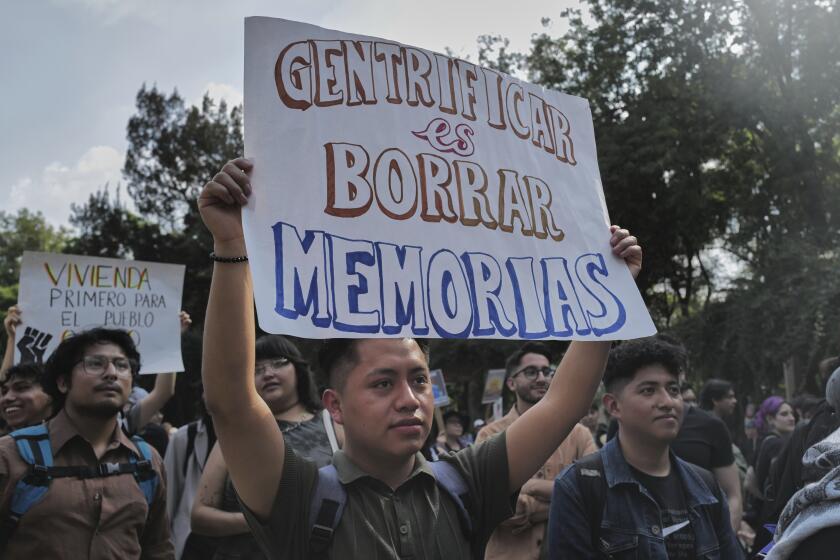Croatian City’s Scars Warn of the Perils of Nationalism
- Share via
VUKOVAR, Croatia — In the eight years since the guns fell silent, shrubs have struggled back to life and a few apartment buildings have been rebuilt. There is again a hint of habitability to this Danube River town that once evoked comparisons to Hiroshima.
Shelled to rubble by the Yugoslav army in 1991, Vukovar is a living monument to the nationalist madness unleashed in the Balkans this decade. To a continent intent on healing its long history of conflict, it is a warning that even in the modern age, political differences can grow into ethnic confrontation.
Of all the borders in the new Europe, some of the blackest lines surround countries that made up the old Yugoslav federation. Resentment still seethes between Serbs and Croats here. And despite the damage it already has caused, the nationalist card still may be used elsewhere to resolve conflicts between reformers and hard-liners.
Reforms and revolutions brought down more-tyrannical regimes in Eastern Europe 10 years ago. But the most avid adherents of the ideology of repression proved to be in one of the region’s freer countries. The Yugoslav federation broke away from Moscow in the 1950s. Its relative wealth and the citizenry’s freedom to travel made the southern Slavs the envy of the Communist world.
Serbs and Croats lived in peace for decades on this fertile riverfront that still forms the border between their lands. Communist leader Josip Broz Tito squelched any hint of nationalism in the old Yugoslavia, and many people look back on those days with nostalgia. People here tended gardens and turned out leather goods from the Borovo factory--a sprawling industrial complex that is now a morbid sculpture of twisted metal and blasted bricks.
It is the kind of sight that is all too common across these Balkan republics. Four wars this decade have left 250,000 people dead and condemned millions more to life as refugees.
In Vukovar, the Serbian-led army besieged and defeated Croatian forces. But in the end, the Serbs lost it all. Vukovar and the rest of the eastern territory was restored to Croatia in late 1997 by a Western-mediated addendum to the Dayton peace accords. The human cost of intolerance is still being counted.
“Serbs here have no rights now. We have nothing,” insists Natasha Rajacic, a 27-year-old elementary school teacher. She and her family were recently evicted from an apartment they occupied when their own home was damaged in the 1991 shelling by fellow Serbs. “We didn’t stay here because we wanted to fight the Croats. It was our home, and we were just trying to save what we could of our lives.”
For eight years, Rajacic and her parents salvaged bricks from the rubble and cobbled together boards for new roofing and money for windows to fix their old home. But the three-story villa still needs interior walls, flooring and heating.
“I don’t know how we can live here during the winter,” the teacher says. She feels unwelcome in Vukovar but has no better place to go.
“It’s worse for us in Serbia,” says Dubravka Cujo, a 34-year-old bank clerk. Her Croatian mother was fired from her nursing job during the Serbian occupation of Vukovar. Her Serbian father lost his livelihood when the shelling destroyed his delivery business.
At the local elementary school where Rajacic teaches, children are segregated into classes of Serbs and Croats, ostensibly so that the nuances of their separate languages and cultures can be preserved. But Serbs see the separation as an attempt by Croats to thwart re-integration.
Those attitudes were encouraged by leaders who used nationalism to build and preserve political power.
When Soviet leader Mikhail S. Gorbachev first eased the strictures on his own federation in the 1980s, other East Europeans saw a chance for democracy and personal freedom. But a little-known Yugoslav banker detected a path to power through the revival of a long-buried Serbian sense of martyrdom.
That banker was Slobodan Milosevic, now the president of Yugoslavia. When he made his move, it empowered a rival nationalist nurturing his own people’s grievances, Croatian President Franjo Tudjman.
Serbs had lived in Croatia, especially in the border regions known as the Krajina, for centuries. When they seized control of those areas in 1991, thousands of Croats fled Serbian bombardment or were expelled in the decade’s first bout of “ethnic cleansing.” But when Serbs lost the territory, thousands of them, especially those who had taken up arms against their Croatian neighbors, fled to Yugoslavia.
Here, about half the region’s original 80,000 Croats have returned to carry on the reconstruction--and often to give their Serbian former tormentors as good as they got.
“There is a very worrying rise in tension. The Serb community is very concerned, and there has been a continued exodus from this country since the NATO bombings [of Yugoslavia],” says Nikolai Ratsiborinsky, deputy chief of the Organization for Security and Cooperation in Europe’s monitoring mission here. “It is a pity, but reconciliation is not progressing at all.”
Croatian officials have been slow to investigate the beating deaths of two Serbs this summer. The inactivity adds to an impression among Serbs, fostered by NATO’s intervention to protect Kosovo Albanians, that it is now open season on Serbs.
“I would be happy to see more Serbs leave,” says Goran Kalazic, 33, a pub owner. “Living separately is the only possibility now.”
Older Croats with memories of the peaceful and prosperous federation built by Tito, are more willing to see Serbian neighbors as fellow victims.
Stipe Beljo, a retired painter, returned to Vukovar over the summer to begin rebuilding his home in the shattered streets between the Danube and the Baroque old town. While the facade is still perforated by bomb fragments, windows on the lower floor of his house had been replaced by a Serbian squatter. The backyard was planted with kiwi and plum trees.
“He wasn’t one of the guilty ones. He was just an old man like me who lost his own home in the Krajina,” Beljo says of the Serb who lived in his house for six years. “The [Yugoslav] army put him here because they thought the Croats would never be coming back.”
As a Croatian army veteran, 40-year-old Ivica Jankovic draws a pension of about $1,000 a month--more than double the average income.
Jankovic recently moved his wife and three children back to the weed-choked ruins here after they had spent eight years as refugees.
Like many Croats, Jankovic makes a distinction between Serbs who heeded Milosevic’s call to arms and those who passively benefited.
“Most of the Serbs who caused trouble came from somewhere else. The local people were more tolerant,” says the ex-soldier, sorting through bricks and bomb-splintered beams in a friend’s yard. “Those who are not guilty will have no reason not to stay.”
But the message from officialdom is anything but welcoming. Among the first construction projects have been war memorials reminding Croats of who caused their suffering.
Vukovar’s main cemetery has been expanded to twice its prewar size to accommodate a field of sleek black marble headstones commemorating locals killed in “the great Serbian aggression.”
“Serbs should see that there’s no life for them here anymore,” says Miron Oros, a 50-year-old retired soldier. “They could have stayed and lived like we did when Tito was alive. But they wanted to take it all.”
More to Read
Sign up for Essential California
The most important California stories and recommendations in your inbox every morning.
You may occasionally receive promotional content from the Los Angeles Times.














